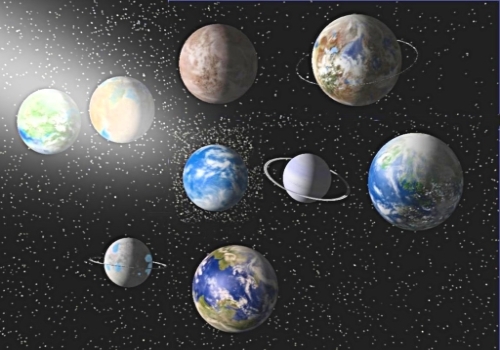BY LETTER
Systems and Worlds
 Image from Steve Bowers |
The foundation of the Galactic Civilization is the solar system. Without the powerhouse of a star to provide raw energy (and sometimes mass for exotic matter conversion) and its family of planets, moons, comets, asteroids, and planetesimal, there could no interstellar society. Civilization expands throughout the universe, making barren space bloom with new life, both biological and aioidal. In the vastness of space, the frontier is endless, resources are limitless, and there is untold wealth to be made by hardy developers, prospectors and colonists who wish to stake their claims and are lucky enough to succeed.
Colonization is never easy. There are hazards in deep space, and very few planets are habitable by baseline Terragen life. Newly claimed solar systems almost always contain nothing but inhospitable planets or asteroids, and sometimes not even that. Terraforming can modify the choicest worlds, making them earthlike, but for the rest C-O life (aerobic carbon-based) depends on sealed domes, habitats, and orbital settlements for living space. Some tweaks are gengineered or bioborgised to live in exotic environments, while xenosophont races like the To'ul'hs are able to live in exotic environments that are difficult to modify for any Terragen metazoa, and vecs and neumanns are able to survive in a wider range of environments than any biologicals, including in a vacuum, provided there is shielding from hard radiation.
Planets, moons, asteroids, comets . . . all provide resources, the opportunity to build habitats and cities and support population and industry. Apart from planets and medium to larger moons, they eventually become so honeycombed through mining and development and habitatization, so filled with industry and commerce and equipment and living space and biospheres, as to become cities and gardens in space. Very few of the citizens of the galaxy actually even live on the surface of a planet.
At present, settled space includes some 50 billion population centers — colonised worlds, moons, and major habitats — with populations ranging from only a few dozen (or even one or two) individuals to many billions. However, the great expanse of space allows populations to spread very widely, and only about a hundred solar systems have more than a billion inhabitants. Most settled worlds have fewer than a thousand sapients.
As civilization expands outwards, further worlds are continually being settled on the periphery. Old worlds rich in millennia of culture and history continue in the Inner Sphere — the center of civilization — and in the developed provincial capitals, but the population there is stable. There are almost a million well-colonized and developed solar systems so far, each with its own unique history.
Sub-Topics
| Systems & Worlds 0 - 9 | Systems & Worlds A - B | Systems & Worlds C - D |
| Systems & Worlds E - F | Systems & Worlds G - H | Systems & Worlds I - J |
| Systems & Worlds K - L | Systems & Worlds M - N | Systems & Worlds O - P |
| Systems & Worlds Q - R | Systems & Worlds S - T | Systems & Worlds U - V |
| Systems & Worlds W - X | Systems & Worlds Y - Z |
Articles
- Earth - Text by M. Alan Kazlev, updated by Stephen Inniss
Earth; Old Earth, the original home of humanity and the origin of the Terragen Civilisation. Now a Caretaker protectorate with limited access. - Master Star List - Text by Mark Ryherd, John M. Dollan and Steve Bowers
The stars of the Inner Sphere and their colonies.
Related Topics
Development Notes
Text by M. Alan Kazlev
Initially published on 05 August 2001.
Initially published on 05 August 2001.
Additional Information






